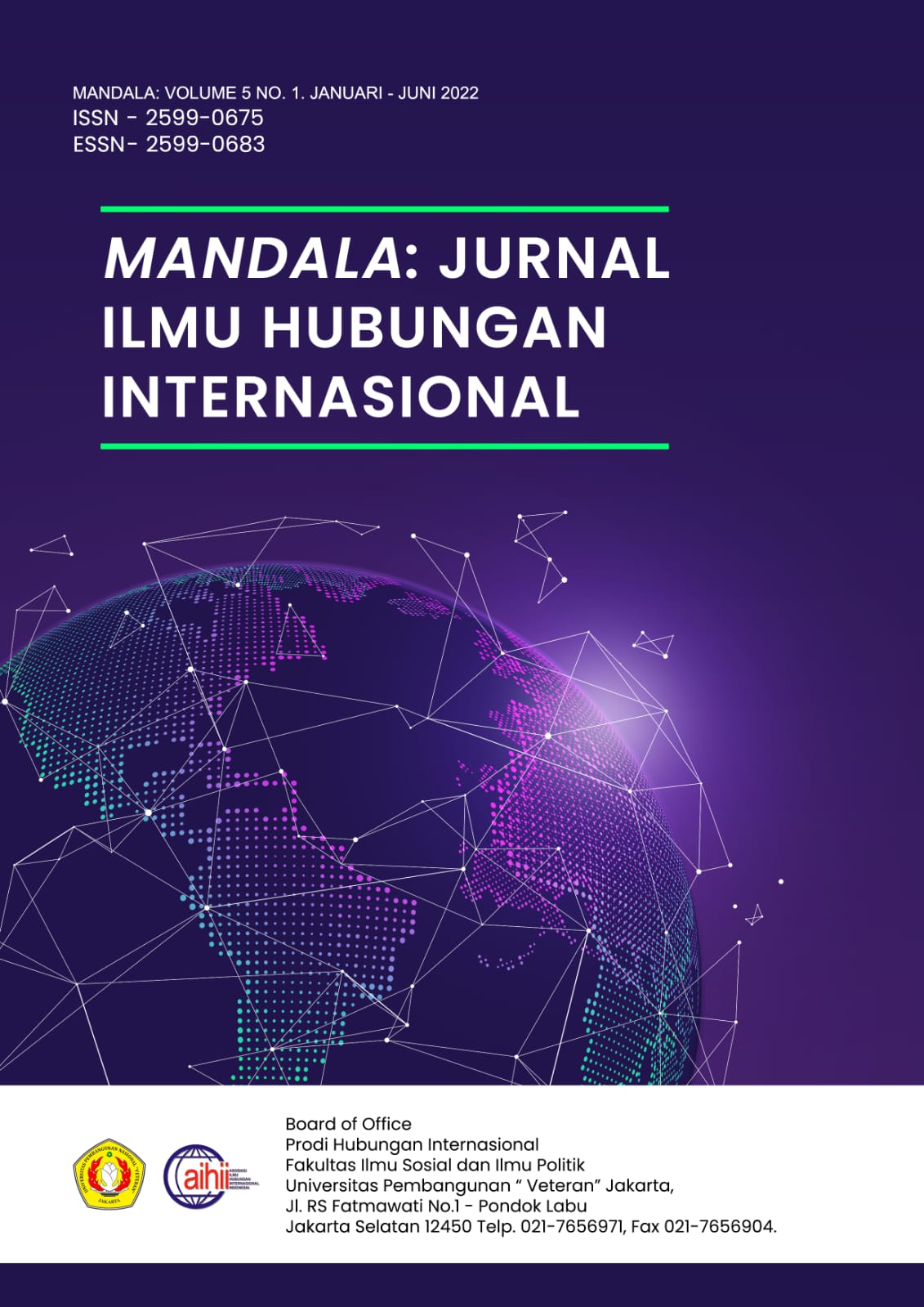China Digital Silk Road And Indonesia Digital Transformation
DOI:
https://doi.org/10.33822/mjihi.v5i2.5047Keywords:
Digital Silk Road, China Foreign Policy, Domestic Politics, Indonesia Foreign PolicyAbstract
The Belt and Road Initiative (BRI), the signature project of the Xi Jinping regime, has established a wide range of lofty goals that would usher in a new chapter of China's integration into the global market system and expand Chinese influence. Notably, China's now-powerful digital companies and cyberspace power actively sought a significant position in this massive statist effort under the policy banner of establishing a Digital Silk Road. Under this project, Beijing has multiple policy mechanisms to spread its digital power. Indonesia's enormous digital economy potential has become a significant target of this project. Using the qualitative method and analyzing two-level games by Robert D Putnam, this research will explain the relationship of Indonesian domestic actors concerning China's digital silk road. This research argues that the digital silk road in Indonesia has made more progress than other BRI projects because the DSR has integrated with the government, private sectors, and parliament's need for digital transformation. When the approval rating of domestic stakeholders is high, the success of the cooperation will be high too.
References
Alami, Athiqah Nur. 2011. “Profil Dan Orientasi Kebijakan Luar Negeri Indonesia.” 8(2): 163–81. http://ejournal.politik.lipi.go.id/index.php/jpp/article/view/459/272.
Alibaba Cloud Press. 2018. “Alibaba Cloud’s Indonesian Data Center Commences Operation | Alibaba Cloud Press Room.” Alibaba Cloud. https://www.alibabacloud.com/press-room/alibaba-clouds-indonesian-data-center-commences-operation (November 4, 2022).
Anderson, Claire. 2010. “Presenting and Evaluating Qualitative Research.” American Journal of Pharmaceutical Education 74(8).
Anggit, Iswari. 2018. “Dari WeChat Hingga Go-Jek, Ini Gurita Bisnis Tencent Di RI.” https://www.cnbcindonesia.com/tech/20181114110210-37-42065/dari-wechat-hingga-go-jek-ini-gurita-bisnis-tencent-di-ri.
Bappenas. 2020. National Mid-Term Development Plan 2020-2024 Rpjmn 2020-2024. https://www.bappenas.go.id/id/data-dan...dan.../rpjmn-2015-2019/.
Bowen, Glenn, A. 2009. “Document Analysis as a Qualitative Research Method.” Qualitative Research Journal 9(2): 27–40.
Bruni, Michele. 2019. “The Belt and Road Initiative. Demographic Trends, Labour Markets and Welfare Systems of Member Countries.” : 1–21. http://hdl.handle.net/10419/191048%0AStandard-Nutzungsbedingungen:
Cheney, Clayton. 2019. 19 China’s Digital Silk Road: Strategic Technological Competition and Exporting Political Illiberalism.
Choiruzzad, Shofwan Albanna, Esther N. S. Tamara, Calvin Khoe, and Steffani Alivia Sugiri. 2022. ASEAN - China Survey 2022: Managing Cooperation Amidst Geopolitical Tensions.
Creswell, John W. 2009. 8 Muqarnas RESEARCH DESIGN: Qualitative, Quantitative, and Mixed Methods Approaches. 3rd Editio. SAGE Publications Ltd.
Damuri, Yose Rizal, Vidhyandika Perkasa Perkasa, Raymond Atje, and Fajar Hirawan. 2019. Perceptions and Readiness of Indonesia Towards the Belt and Road Initiative.
Das, Sanchita Basu. 2017. “OBOR ’ s Digital Connectivity Offers Both Benefits and Risks.” ISEAS Perspective (60): 1–8.
Erie, Matthew S., and Thomas Streinz. 2021. “The Beijing Effect: China’S Digital Silk Road As Transnational Data Governance.” New York University Journal of International Law and Politics 54(1): 1–92. https://heinonline.org/hol-cgi-bin/get_pdf.cgi?handle=hein.journals/nyuilp47§ion=28.
Ferdinand, Peter. 2016. “Westward Ho—the China Dream and ‘One Belt, One Road’: Chinese Foreign Policy under Xi Jinping.” International Affairs 92(4): 941–57.
Fernando, Aldo. 2021. “Royal ‘Bakar Duit’, Begini Gurita Bisnis Alibaba Di Emiten RI.” CNBC Indonesia. https://www.cnbcindonesia.com/market/20210901084306-17-272763/royal-bakar-duit-begini-gurita-bisnis-alibaba-di-emiten-ri.
Google, TEMASEK, and Bain & Company. 2022. E-Conomy of SEA 2022: Through the Waves, towards a Sea of Opportunity.
GT staff reporters. 2021. “China, Indonesia Sign MoU on Internet Security amid Washington Pressure on Beijing’s 5G Technology.” Global Times.
Hemmings, John. 2020. “Reconstructing Order: The Geopolitical Risks in China’s Digital Silk Road.” Asia Policy 15(1): 5–21.
Huawei. 2021. “Huawei Strengthens Contribution and Cooperation in Indonesia Cyber Security.” https://www.huawei.com/en/news/2021/9/tripartite-cooperation-agreement-indonesia-cyber-security.
Johnston, Alastair. 2003. “Is China a Status Quo Power?” International Security 27(4): 5–56.
Johnston, Alastair Iain. 2019. “China in a World of Orders.” International Security 44(2): 9–60.
Katzenstein, Peter J. 1976. “International Relations and Domestic Structures: Foreign Economic Policies of Advanced Industrial States.” International Organization 30(1): 1–45.
Keith, Ronald C. 2018. Deng Xiaoping and China’s Foreign Policy Deng Xiaoping and China’s Foreign Policy. New York: Routledge.
Kennedy, Scott. 2017. The Fat Tech Dragon: Benchmarking China’s Innovation Drive. www.csis.org.
Kominfo. 2015. “Huawei Bangun Pusat Inovasi Untuk Kembangkan SDM Di Bidang ICT.” Kementrian Komunikasi dan Informasi.
Komisi 1. 2022. “DPR Hadiri Pertemuan Parlemen Se-Asia, Bahas Program ‘Belt And Road Initiative.’” DPR RI. https://www.dpr.go.id/berita/detail/id/37176/t/DPR+Hadiri+Pertemuan+Parlemen+se-Asia%2C+Bahas+Program+‘Belt+And+Road+Initiative’ (November 5, 2022).
Ministry of Foreign Affairs of the People’s Republic of China. 2018. “International Strategy of Cooperation on Cyberspace.” Ministry of Foreign Affairs of the People’s Republic of China. https://www.fmprc.gov.cn/mfa_eng/wjb_663304/zzjg_663340/jks_665232/kjlc_665236/qtwt_665250/201703/t20170301_599869.html (November 4, 2022).
Mintz, Alex, and Karl DeRouen. 2010. Understanding Foreign Policy Decision Making. Cambridge, United Kingdom: Cambridge University Press.
Mochamad Yani, Yanyan. 2009. “Change and Continuity in Indonesian Foreign Policy.” Sosiohumaniora 11(1): 1.
Morin, Jean Frédéric, and Jonathan Paquin. 2018. Foreign Policy Analysis: A Toolbox Foreign Policy Analysis: A Toolbox. 2018th ed. Palgrave Macmillan.
National Development and Reform Comission (NDRC), Ministry of Foreign Affairs (MOFA), and Ministry of Commerce (PRC). 2015. White Paper Vision and Actions on Jointly Building Silk Road Economic Belt and 21st-Century Maritime Silk Road. https://en.ndrc.gov.cn/newsrelease_8232/201503/t20150330_1193900.html (March 7, 2020).
Noer, Chandra Hamdani. 2016. “Indonesia-China to Actualize Cooperation on Cyber Defence.” Antara News.
Novotný, Daniel. 2007. “Indonesian Foreign Policy: A Quest for the Balance of Threats The Role and Relevance of Elite Perceptions In Explaining Indonesian Foreign Policy Outcomes DEPARTMENT OF INDONESIAN STUDIES AND SCHOOL OF POLITICS AND INTERNATIONAL RELATIONS FACULTY OF ARTS.” UNIVERSITY OF NEW SOUTH WALES.
Patrick, Stewart M. 2018. “Belt and Router: China Aims for Tighter Internet Controls with Digital Silk Road | Council on Foreign Relations.” Council on Foreign Relations. https://www.cfr.org/blog/belt-and-router-china-aims-tighter-internet-controls-digital-silk-road (November 4, 2022).
Putnam, Robert D. 1988. “Diplomacy and Domestic Politics: The Logic of Two-Level Games.” International Organization 42(3): 427–60.
Shen, Hong. 2018. “Building a Digital Silk Road? Situating the Internet in China’s Belt and Road Initiative.” International Journal of Communication 12: 2683–2701.
Wirajuda, Muhammad Hadianto. 2014. “The Impact of Democratisation on Indonesia’s Foreign Policy: Regional Cooperation, Promotion of Political Values, and Conflict Management.” (August): 1–205. http://etheses.lse.ac.uk/992/1/Wirajuda_Impact_of_Democratisation_on_Indonesias_Foreign_Policy.pdf.
Wübbeke, Jost et al. 2016. “MADE IN CHINA 2025: The Making of a High-Tech Superpower and Consequences for Industrial Countries.” MERICS Papers on China (2): 76. https://www.merics.org/sites/default/files/2018-07/MPOC_No.2_MadeinChina2025_web_0.pdf.





